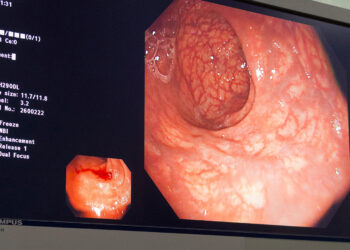Women with high-risk HER2-positive breast cancer lived significantly longer with adjuvant trastuzumab emtansine (T-DM1, Kadcyla), according to long-term follow-up of a large clinical trial.
Estimated overall survival (OS) at 7 years was 89.1% with adjuvant T-DM1 versus 84.4% with adjuvant trastuzumab (Herceptin). Consistent with earlier reports from the study, the 7-year invasive disease-free survival (iDFS) improved from 67.1% with trastuzumab to 80.8% with T-DM1.
Grade ≥3 adverse events occurred more often with T-DM1 but remained consistent with earlier reports, reported Charles E. Geyer Jr., MD, of the UPMC Hillman Cancer Center in Pittsburgh, and co-authors in the New England Journal of Medicine.
“The KATHERINE study was designed to see if we could use neoadjuvant therapy, as opposed to adjuvant therapy, at the time of diagnosis to identify patients whose disease was resistant to the standard therapy,” Geyer told MedPage Today. “We knew from our neoadjuvant trials in breast cancer that a very clear, consistent predictor of poor outcomes was to have residual invasive breast cancer, and the more of it there was, the higher the risk.”
“We know that patients who achieve a pathologic complete response [pCR] with neoadjuvant therapy do quite well and they are pretty much done with therapy,” he continued. “If there’s any residual disease, there is sufficient risk to warrant consideration of adjuvant therapy.”
The primary analysis showed that the addition of adjuvant T-DM1 improved iDFS by 50% versus trastuzumab, and the updated analysis showed a 34% improvement in OS.
Launched in 2012, the multinational KATHERINE trial involved almost 1,500 women with HER2-positive breast cancer and residual disease in the breast or axillary lymph nodes after neoadjuvant trastuzumab and chemotherapy. They were randomly assigned to receive T-DM1 or trastuzumab after surgery. The primary endpoint was iDFS at 3 years, and OS was a key secondary endpoint.
After a median follow-up of 8.4 years, the updated results showed statistically significant improvement in OS with T-DM1 versus trastuzumab (HR 0.66, 95% CI 0.51-0.87, P=0.003), and iDFS also remained significantly in favor of T-DM1 (HR 0.54, 95% CI 0.44-0.66).
Collectively, data from the KATHERINE analyses have “made neoadjuvant therapy standard of care for HER2-positive breast cancer because that’s the only way to identify the subset of patients who derive very substantial benefit from adjuvant therapy with T-DM1,” said Geyer.
KATHERINE has influenced clinical opinion with regard to the intensity of neoadjuvant therapy. Some oncologists have been hesitant about de-escalation, “not give everything we could to get a patient to pathologic complete response.”
“That left the question of: ‘Can we back off some of our therapy?'” said Geyer. “‘Are we overtreating some patients?’ Those studies have been difficult to do, but because of KATHERINE, we have this effective way to salvage patients. That has allowed studies to see whether we can use less neoadjuvant chemotherapy to get to pCR. Then for those patients who didn’t get to pCR, we can give more intensive treatment. The study has had a big impact on the way we treat breast cancer.”
Since the beginning of the KATHERINE trial, the antibody-drug conjugate (ADC) trastuzumab deruxtecan (T-DXd, Enhertu) has compiled an impressive record as treatment for HER2-positive breast cancer. The agent outperformed T-DM1 in a randomized trial in HER2-positive metastatic breast cancer and demonstrated substantial activity in metastatic HER2-positive breast cancer previously treated with T-DM1.
T-DXd also has demonstrated efficacy in the newly minted category of HER2-low breast cancer. Post-hoc analyses of KATHERINE showed the greatest effect of T-DM1 on tumors with high-level expression (HER2 3+) and limited effectiveness in tumors with low-level HER2 expression, said Geyer. On the other hand, T-DM1 has shown some ability to shrink brain metastases, which occur with some regularity in HER2-positive breast cancer. The effect was not apparent in KATHERINE, but investigation of the issue will continue.
Clarity about the superiority of the two trastuzumab-containing ADCs in HER2-positive breast cancer should come from two ongoing randomized trials. Similar to the KATHERINE trial, the DESTINY-Breast05 trial compares T-DXd and T-DM1 in patients with residual disease after neoadjuvant therapy. The SHAMROCK trial compares the two ADCs as neoadjuvant therapy for early HER2-positive breast cancer.
Disclosures
The KATHERINE trial was supported by F. Hoffmann-La Roche/Genentech.
Geyer disclosed relationships with AstraZeneca, Daiichi-Sankyo, Exact Sciences, Hoffmann-La Roche, Genentech, and Roche Products Ltd.
Co-authors reported multiple relationships with industry.
Primary Source
New England Journal of Medicine
Source Reference: Geyer CE, et al “Survival with trastuzumab emtansine in residual HER2-positive breast cancer” N Engl J Med 2025; DOI: 10.1056/NEJMoa2406070.
Source link : https://www.medpagetoday.com/hematologyoncology/breastcancer/113812
Author :
Publish date : 2025-01-16 20:57:04
Copyright for syndicated content belongs to the linked Source.


![author['full_name']](https://newshealth.biz/wp-content/uploads/2025/01/Survival-Benefit-With-Adjuvant-T-DM1-in-High-Risk-HER2-Positive-Breast-Cancer.jpg)












